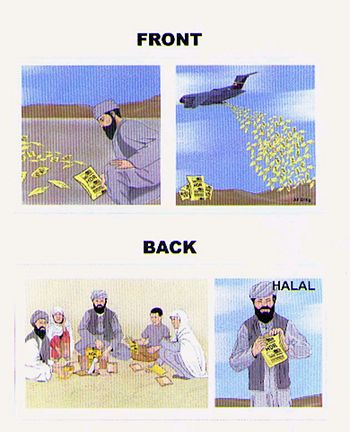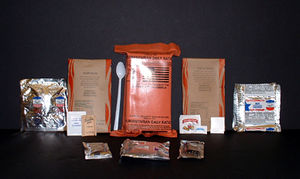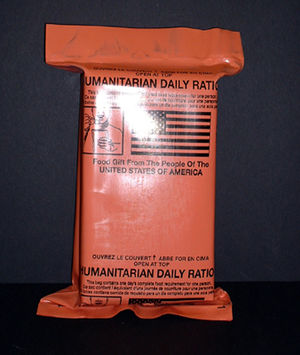Humanitarian daily ration: Difference between revisions
Jump to navigation
Jump to search

imported>George Swan m (Human daily ration moved to Humanitarian daily ration: spelling) |
imported>George Swan (more details) |
||
| Line 5: | Line 5: | ||
'''Human daily ration''' is the name for an emergency ration, with a long shelf-life, intended to be used for refugees | '''Human daily ration''' is the name for an emergency ration, with a long shelf-life, intended to be used for refugees | ||
during natural diasters, or in conflict areas.<ref name=DlaMilHumanDailyRation> | during natural diasters, or in conflict areas.<ref name=DlaMilHumanDailyRation> | ||
{{cite | {{cite web | ||
| url=http://www.dscp.dla.mil/subs/rations/programs/tdsevn.pdf | | url=http://www.dscp.dla.mil/subs/rations/programs/tdsevn.pdf | ||
| title=TECHNICAL DATA FOR HUMANITARIAN DAILY RATION | | title=TECHNICAL DATA FOR HUMANITARIAN DAILY RATION | ||
| Line 11: | Line 11: | ||
| accessdate=2007-10-18 | | accessdate=2007-10-18 | ||
}}</ref><ref name=DefenseLogisticsAgencyOperationalRations> | }}</ref><ref name=DefenseLogisticsAgencyOperationalRations> | ||
{{cite | {{cite web | ||
| url=http://www.dscp.dla.mil/subs/rations/programs/hdr/hdrabt.asp | | url=http://www.dscp.dla.mil/subs/rations/programs/hdr/hdrabt.asp | ||
| title=Operational Rations | | title=Operational Rations | ||
| publisher=[[United States Defense Logistics Agency]] | | publisher=[[United States Defense Logistics Agency]] | ||
| accessdate=2007-10-18 | |||
}}</ref> | |||
The rations were first used in [[Bosnia (country)|Bosnia]] in 1993.<ref name=Defenselink19950802> | |||
{{cite web | |||
| url=http://www.defenselink.mil/news/Aug1995/m080295_m-174-95.html | |||
| title=MEMORANDUM FOR CORRESPONDENTS | |||
| publisher=[[United States Department of Defense]] | |||
| date=[[August 2]], [[1995]] | |||
| accessdate=2007-10-18 | | accessdate=2007-10-18 | ||
}}</ref> | }}</ref> | ||
The meals are designed to be able to survive being air-dropped, without a parachute.<ref name=DcsaHumanitarianDailyRations>. | The meals are designed to be able to survive being air-dropped, without a parachute.<ref name=DcsaHumanitarianDailyRations>. | ||
{{cite | {{cite web | ||
| url=http://www.dsca.mil/programs/HA/HUMANITARIAN%20DAILY%20RATIONS.pdf | | url=http://www.dsca.mil/programs/HA/HUMANITARIAN%20DAILY%20RATIONS.pdf | ||
| title=Humanitarian Daily Rations | | title=Humanitarian Daily Rations | ||
| publisher=[[DCSA]] | | publisher=[[DCSA]] | ||
| accessdate=2007-10- | | accessdate=2007-10-18 | ||
}}</ref> | }}</ref> | ||
This is safer for the refugees than parachuting large palletes of rations. And it prevents hoarding of the meals by a few individuals. | This is safer for the refugees than parachuting large palletes of rations. And it prevents hoarding of the meals by a few individuals. | ||
The meals cost approximately 20 % the cost of a [[meal ready to eat]].<ref name=DcsaHumanitarianDailyRations/>. | The meals cost approximately 20 % the cost of a [[meal ready to eat]].<ref name=DcsaHumanitarianDailyRations/>. | ||
Initially the rations came in a yellow wrapper. But it is the same color as cluster bombs.<ref name=QuartermastAlphabetSoup> | |||
{{cite news | |||
| url=http://www.quartermaster.army.mil/oqmg/professional_bulletin/2001/Winter01/The_Alphabet_Soup_of_Combat_Rations.htm | |||
| title=The Alphabet Soup of Combat Rations | |||
| publisher=[[United States Army]] | |||
| author=[[Albin R. Majewski]] | |||
| date=Winter 2001 | |||
| accessdate=2007-10-18 | |||
}}</ref> | |||
{| class="wikitable" | {| class="wikitable" | ||
Revision as of 19:57, 18 October 2007
Human daily ration is the name for an emergency ration, with a long shelf-life, intended to be used for refugees during natural diasters, or in conflict areas.[1][2]
The rations were first used in Bosnia in 1993.[3]
The meals are designed to be able to survive being air-dropped, without a parachute.[4] This is safer for the refugees than parachuting large palletes of rations. And it prevents hoarding of the meals by a few individuals.
The meals cost approximately 20 % the cost of a meal ready to eat.[4].
Initially the rations came in a yellow wrapper. But it is the same color as cluster bombs.[5]
| Shelf life | 36 months at 80 F |
| Weight | 30 ounces |
| Kilo Calories | at least 2200 per package |
| Protein content | 10-13 percent |
| Fat content | 27-30 percent |
| Carbohydrate content | 60 percent |
| Prohibited contents | Any animal products, except a limited amount of dairy prodcuts, below the limit that would cause a problem for a person with lactose intolerance. |
| Infant component | All rations contain a fruit paste, suitable for feeding to infants |
| Utensils' | All rations contain a spoon and a paper towel moistened with a non-toxic, non-alcoholic cleanser |
References
- ↑ 1.0 1.1 TECHNICAL DATA FOR HUMANITARIAN DAILY RATION. United States Department of Defense. Retrieved on 2007-10-18.
- ↑ 2.0 2.1 Operational Rations. United States Defense Logistics Agency. Retrieved on 2007-10-18.
- ↑ MEMORANDUM FOR CORRESPONDENTS. United States Department of Defense (August 2, 1995). Retrieved on 2007-10-18.
- ↑ 4.0 4.1 4.2 . Humanitarian Daily Rations. DCSA. Retrieved on 2007-10-18.
- ↑ Albin R. Majewski. The Alphabet Soup of Combat Rations, United States Army, Winter 2001. Retrieved on 2007-10-18.


